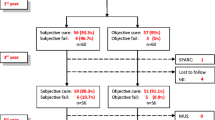Abstract
This study was a 1-year follow-up of a cohort of 52 women who underwent trans-obturator tape (TOT) procedures using Obtape. Follow-up information was available for 45/52 (87%) women. The rate of erosions was 8/52 (15%). Among 34 women examined, 26% experienced tenderness on palpation of operative site, and 72% were objectively cured on pad test. Forty women completed questionnaires (median Incontinence Impact Questionnaire-7, 0; median Urogenital Distress Inventory-6, 17) and of those, 93% would recommend TOT to a friend. We found a high rate of erosions among our cohort. Our high rate of erosions may be a result of our review of the majority of the cohort, and it is likely related to the specific device used (Obtape). The majority of women were satisfied with the outcome. Before introducing new procedures into widespread clinical practice, it is important to rigorously investigate their outcomes.

Similar content being viewed by others
References
Delorme E (2001) La bandelette transobturatrice: un procédé mini-invasif pour traiter l’incontinence urinaire chez la femme. Prog Urol 11:1306–1313
Robert M, Murphy M, Birch C, Swaby C, Ross S (2006) Five cases of tape erosion following transobturator surgery for urinary incontinence. Obstet Gynecol 107(2 Pt 2):472–474
Uebersax JS, Wyman JF, Shumaker SA, McClish DK, Fantl JA (1995) Short forms to assess life quality and symptom distress for urinary incontinence in women: the Incontinence Impact Questionnaire and the Urogenital Distress Inventory. Continence Program for Women Research Group. Neurourol Urodyn 14:131–139
Abrams P, Blaivas JG, Stanton SL, Andersen JT (1988) The standardisation of terminology of lower urinary tract function. The International Continence Society Committee on Standardisation of Terminology. Scand J Urol Nephrol Suppl 114:5–19
Jorgensen JB, Colstrup H, Frimodt-Moller C (1998) Uroflow in women: an overview and suggestions for the future. Int Urogynecol J 9:33–36
Cindolo L, Salzano L, Rota G, Bellini S, D’Afiero A (2003) Tension-free transobturator approach for female stress urinary incontinence. Minerva Urol Nefrol 55:89–98
Mellier G, Benayed B, Bretones S, Pasquier JC (2004) Suburethral tape via the obturator route: is the TOT a simplification of the TVT? Int Urogynecol J Pelvic Floor Dysfunct 15:227–232
Costa P, Grise P, Droupy S, Monneins F, Assenmacher C, Ballanger P, Hermieu JF, Delmas V, Boccon-Gibod L, Ortuno C (2004) Surgical treatment of female stress urinary incontinence with a trans-obturator-tape (TOT) Uratape: short-term results of a prospective multicentric study. Eur Urol 46(1):102–106
Krauth JS, Rasoamiaramanana H, Barletta H, Barrier PY, Grisard-Anaf M, Lienhart J, Mermet J, Vautherin R, Frobert JL (2005) Sub-urethral tape treatment of female urinary incontinence-morbidity assessment of the trans-obturator route and a new tape (I-STOP): a multi-center experiment involving 604 cases. Eur Urol 47(1):102–107
Domingo S, Alma P, Ruiz N, Perales A, Pellicer A (2005) Diagnosis, management and prognosis of vaginal erosion after transobturator suburethral tape procedure using a nonwoven thermally bonded polypropylene mesh. J Urol 173:1627–1630
Spinosa JP, Dubuis PY (2005) Suburethral sling inserted by the transobturator route in the treatment of female stress urinary incontinence: preliminary results in 117 cases. Eur J Obstet Gynecol Reprod Biol 123(2):212–217
Roumeguère T, Quackels T, Bollens R, de Groot A, Zlotta A, Vanden Bossche M, Schulman C (2005) Trans-obturator vaginal tape (TOT) for female stress incontinence: one year follow-up in 120 patients. Eur Urol 48:805–809
Barry C, Naidu A, Lim Y, Corsitaans A, Muller R, Rane A (2005) Does the MONARC transobturator suburethral sling cause post-operative voiding dysfunction? A prospective study. Int Urogynecol J Pelvic Floor Dysfunct 17(1):30–34
Dietz HP, Vancaillie P, Svehla M, Walsh W, Steensma AB, Vancaillie TG (2003) Mechanical properties of urogynecologic implant materials. Int Urogynecol J Pelvic Floor Dysfunct 14(4):239–243
Cosson M, Debodinance P, Boukerrou M, Chauvet MP, Lobry P, Crepin G, Ego A (2003) Mechanical properties of synthetic implants used in the repair of prolapse and urinary incontinence in women: which is the ideal material? Int Urogynecol J Pelvic Floor Dysfunct 14(3):169–178
Costa P, Delmas V (2004) Trans-obturator-tape procedure, “inside out or outside in”: current concepts and evidence base. Curr Opin Urol 14(6):313–315
Richards SR, Balaloski SP (2005) Vulvar hematoma following a transobturator sling (TVT-O). Int Urogynecol J Pelvic Floor Dysfunct :1–2 (Epub ahead of print)
Caquant F, Collinet P, Deruelle P, Lucot JP, Cosson M (2005) Perineal cellulitis following trans-obturator sub-urethral tape Uratape. Eur Urol 47(1):108–110
Game X, Mouzin M, Vaessen C, Malavaud B, Sarramon J-P, Rischmann P (2004) Obturator infected hematoma and urethral erosion following transobturator tape implantation. J Urol 171:1629
Babalola EO, Famuyide AO, McGuire LJ, Gebhart JB, Klingele CJ (2005) Vaginal erosion, sinus formation, and ischiorectal abscess following transobtutator tape: ObTape implantation. Int Urogynecol J Pelvic Floor Dysfunct:1–4 (Epub ahead of print)
Mahajan ST, Kenton K, Bova DA, Brubaker L (2006) Transobturator tape erosion associated with leg pain. Int Urogynecol J Pelvic Floor Dysfunct 17(1):66–68
But I (2005) Vaginal wall erosion after transobturator tape procedure. Int Urogynecol J Pelvic Floor Dysfunct 16(6):506–508
Ross S, Soroka D, Karahalios A, Glazener CMA, Hay-Smith EJC, Drutz HP (2005) Incontinence-specific quality of life measures used in trials of treatments for female urinary incontinence: a systematic review. Int Urogynecol J Pelvic Floor Dysfunct (Epub ahead of print)
Acknowledgement
The follow-up study was funded by the Adult Research Committee of the Calgary Health Region.
Author information
Authors and Affiliations
Corresponding author
Rights and permissions
About this article
Cite this article
Dobson, A., Robert, M., Swaby, C. et al. Trans-obturator surgery for stress urinary incontinence: 1-year follow-up of a cohort of 52 women. Int Urogynecol J 18, 27–32 (2007). https://doi.org/10.1007/s00192-006-0115-9
Received:
Accepted:
Published:
Issue Date:
DOI: https://doi.org/10.1007/s00192-006-0115-9




